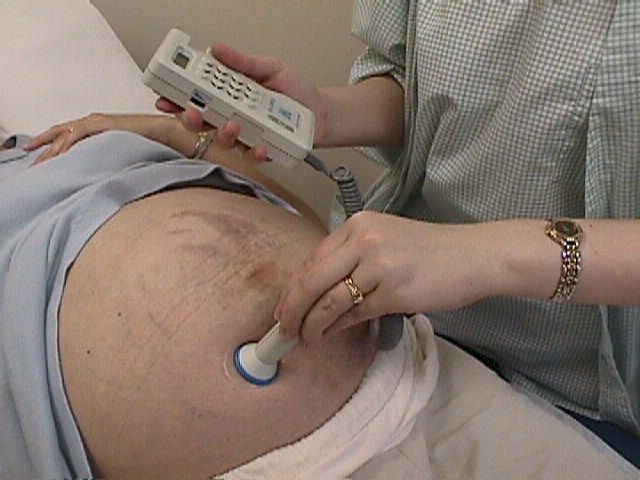Prenatal Care
First Prenatal Visit · EDC
· Laboratory Tests
· Subsequent Visits
· Weight
· Blood Pressure
· Urine
Protein/Glucose · Edema
· Fundal Height
· Fetal Heartbeat
· Fetal Movement
· Fetal Orientation
First Prenatal Visit
At the first prenatal visit, take a careful history, looking for factors
that might increase the risk for the pregnant woman.
Many providers use
a questionnaire, filled out by the patient, as a starting point for this
evaluation. A sample Prenatal
Registration and Obstetrical Questionnaire form can be used for this
purpose.
One important aspect of prenatal care
is education of the pregnant woman about her pregnancy, danger signs,
things she should do and things she should not do.
Many providers find
it useful to give the woman printed material covering these issues that
she can take with her. This allows her to read the material at a later
time and to refer to it whenever she has questions. A sample Prenatal
Information form can be printed and used.
Early in pregnancy, often at the first prenatal visit, a complete
physical exam is performed. At that time, a Pap smear and cervical
cultures are obtained. In many practices, an ultrasound scan is done at
or shortly after the first visit to:
-
Confirm intrauterine pregnancy placement
-
Confirm fetal viability
-
Confirm the number of fetuses
-
Provide a highly reliable estimate of gestational age
It is valuable to document your findings in a structured flow-sheet.
Many offices and hospitals have developed their own, but one is shown
here:
Prenatal Flow
Sheet
There are so many issues to cover during the first
prenatal visit (history, physical, labs, patient education,
paperwork), that many physicians schedule two "first prenatal visits."
EDC
Based on the history, physical exam and ultrasound scan (if done), it is
important to establish a gestational age and estimated date of
confinement (EDC, or "Due Date").
You may use the last menstrual
period, if known, reliable, and the patient has a history of regular
periods. Add 280 days (40 0/7 weeks) to the LMP and this will give you
her EDC. This assumes that she ovulated on day #14 of her last menstrual
cycle. To assist you in making this calculation, I'm enclosing a LMP to
EDC conversion chart here:
Gestational Age Calculator
You may take the LMP, add 7 days and
subtract 3 months. This is a rough but usable adaptation of the 280 day
rule. It has the same limitations.
You may measure the fundal height (distance from the symphysis to the
top of the uterus). That distance in centimeters is roughly equal to the
weeks gestation of the patient.
Estimates of gestational age and EDC are best done early in pregnancy
when the patient's memory is the best, and the variation is uterine size
and fetal size is small.
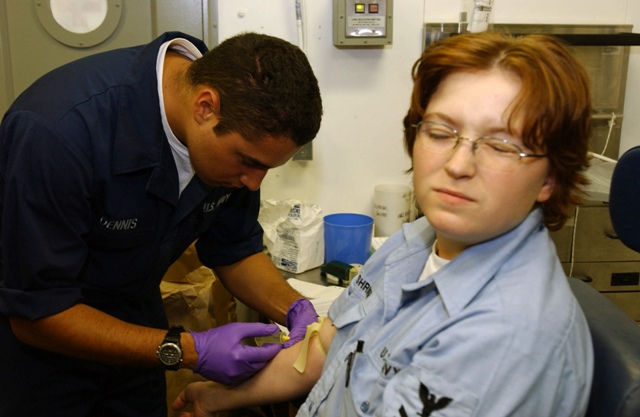 Initial Lab Tests Initial Lab Tests
Shortly after registration, initial laboratory tests are ordered.
Later in pregnancy, other tests are usually performed. Physician
preference and patient population guide some of the choice of these
tests, but commonly-ordered tests include:
Subsequent Lab Tests
Subsequent Visits
-
every 4 weeks until 28 weeks' gestation
-
every 2-3 weeks until 36 weeks' gestation
-
every week from 36 weeks to delivery
At these visits, you will want to ask the patient about any interval
changes. You'll also want to know about any vaginal discharge or
bleeding, fetal movements, and uterine contractions.
At each visit, perform a limited physical exam, consisting of weight, blood pressure, edema, fundal height, fetal heart rate, and note the
presence or absence of proteinuria and glucosuria.
At times, it may be important to determine fetal orientation.
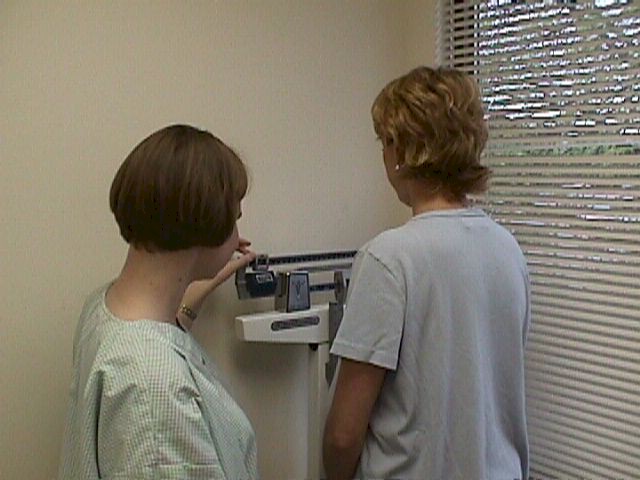 Check weight Check weight
Typical weight gain is about a pound a week. This means 30 to
40 pounds for the entire pregnancy, although some physicians feel the
ideal weight gain should be closer to 25 pounds.
Weight gain is usually slow during the first 20 weeks.
Then, there is usually rapid weight gain from 20 to 32 weeks. After
that, weight gain generally slows and there may be little, if any weight
gain during the last few weeks.
Too little weight gain (below 13 pounds) leads to concerns that the
baby may not be getting enough nutrition.
Too much weight gain leads to concerns about soft tissue dystocia
during labor and difficulty with restoring normal weight after delivery.
If there is sudden weight gain (more than 2 pounds in a week or more
than 6 pounds in a month), this may be associated with the development
of fluid retention due to pre-eclampsia (toxemia of pregnancy).
Blood Pressure
Measure the blood pressure at each prenatal visit. Significant
cardiovascular changes occur during pregnancy, including a 50% increase
in blood volume, 50% increase in cardiac output, significant reduction
in peripheral resistance, and a mild, sustained tachycardia. While these
changes are taking place, I would make the following generalizations
about blood pressure:
-
Blood pressure in early pregnancy will usually reflect
pre-pregnancy levels.
-
During the 2nd trimester, maternal blood pressures
usually fall below prepregnancy levels.
-
During the 3rd trimester, blood pressure usually goes
back up to the pre-pregnancy level.
-
Any sustained BP of 140/90 or greater is considered
significant and may indicate the development of
pre-eclampsia.
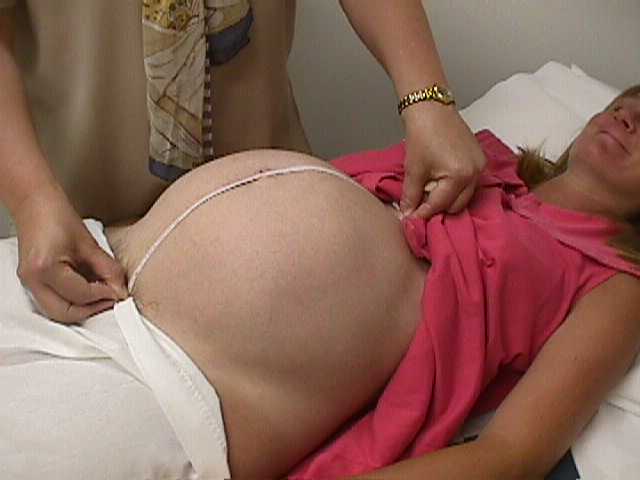 Fundal Height Fundal Height
Use a tape measure to record the size of the uterus. The fundal
height, measured in cm, should be approximately equal to the weeks
gestation, from mid-pregnancy until near term (MacDonald's Rule).
Measurements falling within 1-3 cm of the expected value are considered
normal. Fundal heights 4 cm different than expected are considered
abnormal and suggest the need for further investigation.
If the measurements are too small, consider:
-
Your estimate of gestational age may be incorrect
-
There may be very little amniotic fluid (oligohydramnios).
-
The baby may be small for gestational age (or growth retarded)
-
The baby may be normal, but simply constitutionally small.
If the measurements are too big, consider:
-
Your estimate of gestational age may be incorrect
-
There may be too much amniotic fluid (polyhydramnios)
-
The baby may be large for gestational age (as is seen in
gestational diabetes)
-
The baby may be normal, but constitutionally large.
Listen for the heartbeat
The normal rate is generally considered to be between 120 and
160 beats per minute.
-
The rates are typically higher (140-160) in early
pregnancy, and lower (120-140) toward the end of pregnancy.
-
Past term, some normal fetal heart rates fall to 110
BPM.
-
There is no correlation between heart rate and the
gender of the fetus.
Use a coupling agent (eg, Ultrasound jel, surgical lubricant, or even
water) to make a good acoustical connection between the transducer and
the skin.
Doppler fetal heartbeat detectors are moderately directional, so
unless you happen to aim it directly at the fetal heart initially, you
will need to move it or angle it to find the heartbeat.
Confirm a normal rate, and listen for any abnormalities in the rhythm
of the fetal heart beat.
Check for edema
Swelling of the feet, ankles and hands is common during
pregnancy. If mild, and in the absence of hypertension, the patient can
be reassured that:
-
This is a normal occurrence
-
While unpleasant, it is not dangerous
-
It will resolve spontaneously after the baby is born.
-
It may take weeks for the edema to resolve after
delivery.
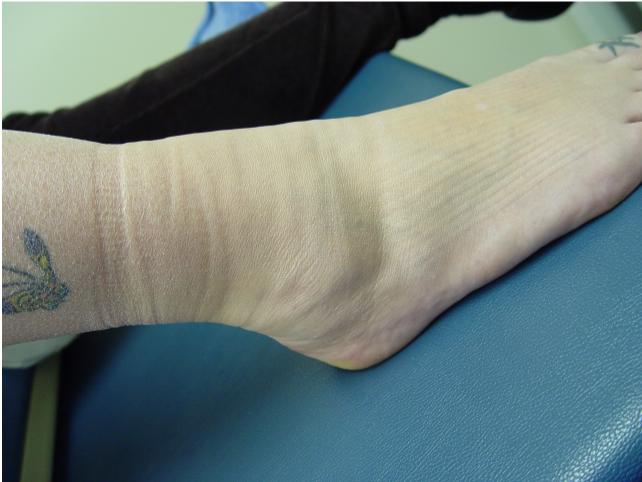
Edema of the ankle and foot, with marks
from the elastic of the patient's socks indenting the skin. |
Facial edema, severe pedal edema, or any sudden increase
in edema can be a sign of developing pre-eclampsia, so the BP should be
checked. Usually, rapid accumulation of extracellular fluid is
accompanied by a significant weight gain in a very short time.
It is not necessary to treat simple edema, in the absence of pre-eclampsia.
However, some patients are so uncomfortable or their edema is so
substantial that you may feel compelled to treat the patient. One
effective treatment for edema is bed rest for 2-3 days, while drinking
plenty of plain water and avoiding excessive salt. This technique:
Check urine protein and glucose
A urine dipstick test for protein is generally negative or
trace during pregnancy. If 1+ (30 mg/dl) or more, it is considered
significant.
Category |
Negative
Protein |
Trace
Protein |
1+
Protein |
2+
Protein |
3+
Protein |
4+
Protein |
Dipstick Results |
<15 mg/dL |
15-29 mg/dL |
30 mg/dL |
100 mg/dl |
300 mg/dl |
>2000 mg/dL |
Equivalent
24-hour Protein |
<150 mg |
150-299 mg |
300-999 mg |
1000-2999 mg |
3-20 g |
>20 g |
For glucose, urine normally shows negative or trace. If persistently
1/4 (250 gm/dl) or more, it is considered significant.
Ask about fetal activity
Although fetal movement can be documented by ultrasound as
early as 7-8 weeks of pregnancy, fetal movement is not usually felt by
the mother until the 16th week (for women who have delivered a baby) to
the 20th week (for women pregnant for the first time).
Once they positively identify fetal movement, most women will
acknowledge that they have been feeling the baby move for a week or two,
but didn't realize that the sensation (fluttery movements) was from the
baby.
Movements generally increase in strength and frequency through
pregnancy, particularly at night, when the woman is at rest. At the end
of pregnancy (36 weeks and beyond), there is normally a slow change in
movements, with fewer violent kicks and more rolling and stretching
fetal movements. A sudden decrease in fetal movement is a danger sign
that needs to be reported and investigated immediately.
"Kick counts" are sometimes recommended to patients as a means of
quantifying fetal movement. One common way of doing a kick count is to
ask the woman to count each distinct fetal movement, starting from the
time she awakens in the morning. When she reaches 10 movements or kicks,
she is done counting for the day. If she gets to 12 noon and hasn't
reached a count of 10 movements, she reports this to her provider and
further testing is done.
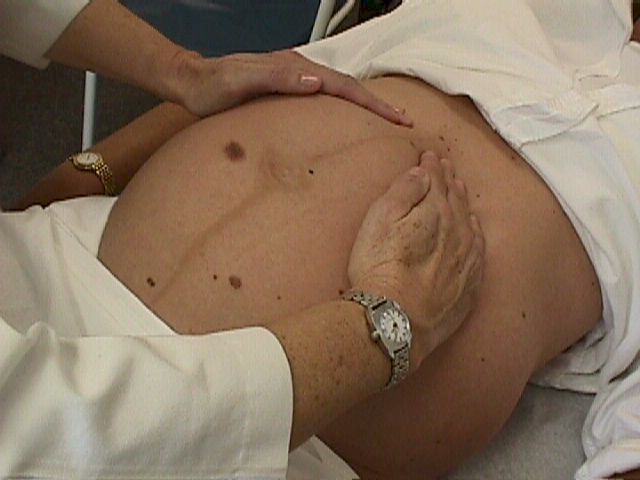 Fetal Orientation Fetal Orientation
The presentation (head first, breech first, transverse lie) and position
(anterior, posterior, transverse) can be determined in several ways:
-
An ultrasound scan will confirm the presentation and position any
time it is needed.
-
An x-ray of the abdomen can provide nearly as much information as
the ultrasound scan, but exposes both the mother and fetus to
radiation and thus is rarely used.
-
Clinical examination of the abdomen (Leopold's Maneuvers) can
provide very reliable information, although the more experienced the
examiner, the more reliable the information. Patient habitus also
makes this exam easier or more difficult.
Read more about Leopold's Maneuvers |




